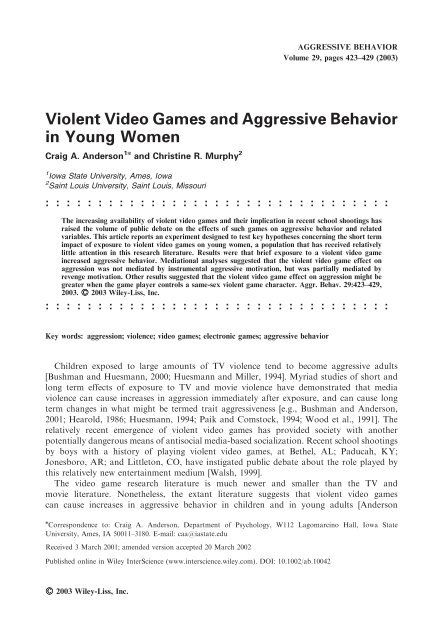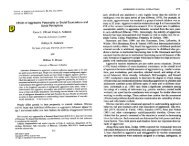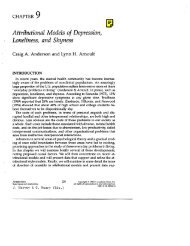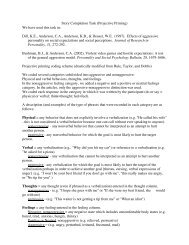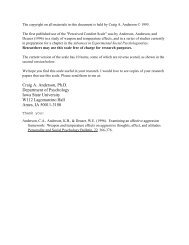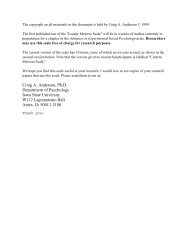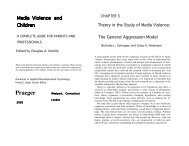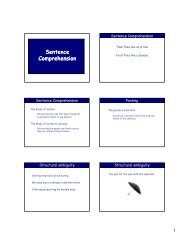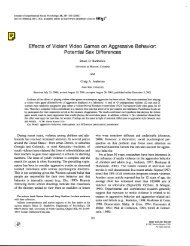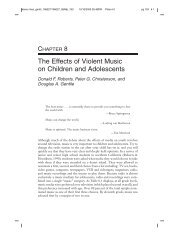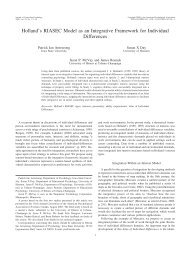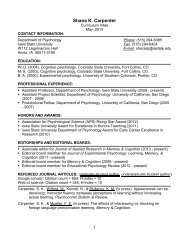Violent Video Games and Aggressive Behavior in Young Women
Violent Video Games and Aggressive Behavior in Young Women
Violent Video Games and Aggressive Behavior in Young Women
Create successful ePaper yourself
Turn your PDF publications into a flip-book with our unique Google optimized e-Paper software.
AGGRESSIVE BEHAVIOR<br />
Volume 29, pages 423–429 (2003)<br />
<strong>Violent</strong> <strong>Video</strong> <strong>Games</strong> <strong>and</strong> <strong>Aggressive</strong> <strong>Behavior</strong><br />
<strong>in</strong> <strong>Young</strong> <strong>Women</strong><br />
Craig A. Anderson 1n <strong>and</strong> Christ<strong>in</strong>e R. Murphy 2<br />
1 Iowa State University, Ames, Iowa<br />
2 Sa<strong>in</strong>t Louis University, Sa<strong>in</strong>t Louis, Missouri<br />
: : : : : : : : : : : : : : : : : : : : : : : : : : : : : : : : :<br />
The <strong>in</strong>creas<strong>in</strong>g availability of violent video games <strong>and</strong> their implication <strong>in</strong> recent school shoot<strong>in</strong>gs has<br />
raised the volume of public debate on the effects of such games on aggressive behavior <strong>and</strong> related<br />
variables. This article reports an experiment designed to test key hypotheses concern<strong>in</strong>g the short term<br />
impact of exposure to violent video games on young women, a population that has received relatively<br />
little attention <strong>in</strong> this research literature. Results were that brief exposure to a violent video game<br />
<strong>in</strong>creased aggressive behavior. Mediational analyses suggested that the violent video game effect on<br />
aggression was not mediated by <strong>in</strong>strumental aggressive motivation, but was partially mediated by<br />
revenge motivation. Other results suggested that the violent video game effect on aggression might be<br />
greater when the game player controls a same-sex violent game character. Aggr. Behav. 29:423–429,<br />
2003. r 2003 Wiley-Liss, Inc.<br />
: : : : : : : : : : : : : : : : : : : : : : : : : : : : : : : : :<br />
Key words: aggression; violence; video games; electronic games; aggressive behavior<br />
Children exposed to large amounts of TV violence tend to become aggressive adults<br />
[Bushman <strong>and</strong> Huesmann, 2000; Huesmann <strong>and</strong> Miller, 1994]. Myriad studies of short <strong>and</strong><br />
long term effects of exposure to TV <strong>and</strong> movie violence have demonstrated that media<br />
violence can cause <strong>in</strong>creases <strong>in</strong> aggression immediately after exposure, <strong>and</strong> can cause long<br />
term changes <strong>in</strong> what might be termed trait aggressiveness [e.g., Bushman <strong>and</strong> Anderson,<br />
2001; Hearold, 1986; Huesmann, 1994; Paik <strong>and</strong> Comstock, 1994; Wood et al., 1991]. The<br />
relatively recent emergence of violent video games has provided society with another<br />
potentially dangerous means of antisocial media-based socialization. Recent school shoot<strong>in</strong>gs<br />
by boys with a history of play<strong>in</strong>g violent video games, at Bethel, AL; Paducah, KY;<br />
Jonesboro, AR; <strong>and</strong> Littleton, CO, have <strong>in</strong>stigated public debate about the role played by<br />
this relatively new enterta<strong>in</strong>ment medium [Walsh, 1999].<br />
The video game research literature is much newer <strong>and</strong> smaller than the TV <strong>and</strong><br />
movie literature. Nonetheless, the extant literature suggests that violent video games<br />
can cause <strong>in</strong>creases <strong>in</strong> aggressive behavior <strong>in</strong> children <strong>and</strong> <strong>in</strong> young adults [Anderson<br />
n Correspondence to: Craig A. Anderson, Department of Psychology, W112 Lagomarc<strong>in</strong>o Hall, Iowa State<br />
University, Ames, IA 50011–3180. E-mail: caa@iastate.edu<br />
Received 3 March 2001; amended version accepted 20 March 2002<br />
Published onl<strong>in</strong>e <strong>in</strong> Wiley InterScience (www.<strong>in</strong>terscience.wiley.com). DOI: 10.1002/ab.10042<br />
r 2003 Wiley-Liss, Inc.
424 Anderson <strong>and</strong> Murphy<br />
<strong>and</strong> Bushman, 2001; Anderson <strong>and</strong> Dill, 2000; Dill <strong>and</strong> Dill, 1998]. However, there<br />
are serious gaps [Anderson, 2002]. One is the paucity of experimental research on violent<br />
video game effects on young women. This is a particularly <strong>in</strong>terest<strong>in</strong>g group because of<br />
frequent claims that violent media have little impact on females <strong>and</strong> young adults.<br />
Historically, girls <strong>and</strong> young women have spent relatively less time play<strong>in</strong>g computer games<br />
<strong>in</strong> general than boys <strong>and</strong> young men, <strong>and</strong> show less <strong>in</strong>terest <strong>in</strong> play<strong>in</strong>g violent games<br />
[Buchman <strong>and</strong> Funk, 1996; Rideout et al., 1999]. This, <strong>in</strong> conjunction with the fact that<br />
females are less likely to commit violent crimes, may account for the lack of research<br />
attention to this group. To date, there are only two published experimental studies <strong>in</strong> which<br />
the effects of exposure to violent video games on young women’s aggressive behavior<br />
is explicitly addressed. Anderson <strong>and</strong> Dill [Study 2, 2000] found a small but reliable <strong>in</strong>crease<br />
<strong>in</strong> females’ aggressive behavior as a result of play<strong>in</strong>g a violent video game. Bartholow<br />
<strong>and</strong> Anderson [2002] found a significant <strong>in</strong>crease <strong>in</strong> aggression on one measure, but not on<br />
another.<br />
The Present Experiment<br />
One goal of the present experiment was to conduct a conceptual replication of violent<br />
video game effects on aggression by young women. A second goal was to provide a<br />
prelim<strong>in</strong>ary look at one potential moderat<strong>in</strong>g variable of violent video game effects—gender<br />
of the controlled character. From the TV/movie violence literature, we know that factors<br />
which <strong>in</strong>crease identification with an aggressive character tend to <strong>in</strong>crease the media violence<br />
effect. One obvious factor is the gender match between the participant <strong>and</strong> the video game<br />
character controlled by the participant. Of course, <strong>in</strong> all violent video games players must<br />
identify with their violent game characters to some extent <strong>in</strong> order to play the game. Thus,<br />
add<strong>in</strong>g other features designed to <strong>in</strong>crease identification with the ma<strong>in</strong> character may have<br />
relatively little impact. But, it is certa<strong>in</strong>ly possible that controll<strong>in</strong>g a same sex character will<br />
<strong>in</strong>crease identification with that character, <strong>and</strong> hence may <strong>in</strong>crease the effect on subsequent<br />
behavior. F<strong>in</strong>ally, the experiment was designed to look at two potential mediat<strong>in</strong>g<br />
variables—<strong>in</strong>strumental aggressive motivation <strong>and</strong> revenge motivation (hostile aggression<br />
motivation).<br />
METHOD<br />
Participants<br />
N<strong>in</strong>ety-one female undergraduates enrolled <strong>in</strong> an <strong>in</strong>troductory psychology class<br />
participated for course credit. Participants were r<strong>and</strong>omly assigned to one of three<br />
conditions: 33 played a violent video game with a female protagonist; 30 played a violent<br />
video game with a male protagonist; 27 played a nonviolent video game. Data from one<br />
participant were discarded because of miss<strong>in</strong>g values on key mediat<strong>in</strong>g variables.<br />
MATERIALS<br />
<strong>Video</strong> games. Participants played one of two video games: Street Fighter II, orOh No!<br />
More Lemm<strong>in</strong>gs. Street Fighter is a third person fight<strong>in</strong>g game, <strong>in</strong> which the player controls<br />
an on-screen character (male or female) who engages <strong>in</strong> a series of fights with other
<strong>Violent</strong> <strong>Video</strong> <strong>Games</strong> 425<br />
characters. It is a ‘‘third person’’ game because the player sees her character from an external<br />
perspective. Street Fighter was played on a Sony Playstation video game system with a<br />
19–<strong>in</strong>ch television. Lemm<strong>in</strong>gs is a children’s game that <strong>in</strong>volves help<strong>in</strong>g lemm<strong>in</strong>gs reach<br />
safety by direct<strong>in</strong>g them to safe routes, by cutt<strong>in</strong>g holes through walls, build<strong>in</strong>g steps over<br />
pitfalls, <strong>and</strong> through other similar means. Lemm<strong>in</strong>gs was played on a Mac<strong>in</strong>tosh computer.<br />
Both games are relatively simple to learn, <strong>and</strong> thus do not require much practice. After<br />
play<strong>in</strong>g the assigned game, participants performed the competitive reaction time task.<br />
Competitive reaction time task. A modified version of the Taylor Competitive Reaction<br />
Time (TCRT) task was used to assess aggressive behavior. The TCRT is a widely used <strong>and</strong><br />
externally valid measure of aggression [Anderson et al., 1999; Carlson et al., 1989; Giancola<br />
<strong>and</strong> Chermack, 1998]. TCRT participants compete with a fictitious person to see who can<br />
respond first upon presentation of a tone. After each trial the ‘‘loser’’ receives an aversive<br />
stimulus (e.g., loud noise), the <strong>in</strong>tensity of which is supposedly set by the opponent. There is<br />
no real opponent. The pattern of w<strong>in</strong>s/losses <strong>and</strong> the <strong>in</strong>tensity of aversive stimuli received by<br />
the participant on ‘‘lose’’ trials are predeterm<strong>in</strong>ed. The participant’s aversive stimulus sett<strong>in</strong>gs<br />
for the ‘‘opponent’’ constitute the measure of aggressive behavior.<br />
In this study we used a two-phase version of the task, one that we have successfully used <strong>in</strong><br />
several experimental studies of aggression [Anderson et al., 2000; Bartholow <strong>and</strong> Anderson,<br />
2002; L<strong>in</strong>dsay <strong>and</strong> Anderson, 2000]. Phase 1 of this Retaliation Competitive Reaction<br />
Time task (RCRT) consists of 25 trials <strong>in</strong> which the ‘‘opponent’’ sets the <strong>in</strong>tensity of aversive<br />
noise to be delivered to the participant on ‘‘lose’’ trials. Possible sett<strong>in</strong>gs are from 1<br />
(55 decibels) to 10 (105db). A ‘‘zero’’ no noise option is also available. The participant sees<br />
the <strong>in</strong>tensity supposedly set by the opponent on each trial, <strong>and</strong> receives a noise blast of this<br />
<strong>in</strong>tensity on ‘‘lose’’ trials. However, the participant does not set noise levels for her opponent<br />
<strong>in</strong> Phase 1. Phase 2 is identical, except that the roles are reversed. The participant’s aversive<br />
noise sett<strong>in</strong>gs (0–10), supposedly to be delivered to the opponent, constitute the aggression<br />
measure.<br />
All participants received the same series of 13 w<strong>in</strong>s <strong>and</strong> 12 losses <strong>in</strong> Phase 1. Trial 1 was a<br />
‘‘w<strong>in</strong>.’’ The rema<strong>in</strong><strong>in</strong>g 24 trials were divided <strong>in</strong>to three blocks of eight, with the participant<br />
w<strong>in</strong>n<strong>in</strong>g <strong>and</strong> los<strong>in</strong>g half <strong>in</strong> each block. The pattern of noise sett<strong>in</strong>gs by the supposed<br />
opponent was an <strong>in</strong>creas<strong>in</strong>g provocation pattern [Anderson et al., 2000]. The sett<strong>in</strong>gs ranged<br />
from 2–4 (60–70db) <strong>in</strong> Block 1, 4–7 (70–85db) <strong>in</strong> Block 2, <strong>and</strong> 7–9 (85–95db) <strong>in</strong> Block 3.<br />
At the conclusion of Phase 1 the experimenter rem<strong>in</strong>ded participants that <strong>in</strong> Phase 2 they<br />
would set noise <strong>in</strong>tensities for their opponent <strong>and</strong> would not themselves receive noise.<br />
Participants were given sample noise blasts of ‘‘2’’ (60db) <strong>and</strong> ‘‘8’’ (90db) prior to Phase 1.<br />
The measure of aggressive behavior was the same as one recently reported by Bartholow <strong>and</strong><br />
Anderson [2002]—the number of attempts to deliver high <strong>in</strong>tensity noise blasts (sett<strong>in</strong>gs 8–10)<br />
to the opponent across the 25 trials of Phase 2.<br />
Questionnaire. Follow<strong>in</strong>g the RCRT task, participants answered a number of questions<br />
about the experiment, modelled on a questionnaire used by Bartholow <strong>and</strong> Anderson<br />
[2002]. Six items asked participants to ‘‘<strong>in</strong>dicate the extent to which this motive describes<br />
your motive when decid<strong>in</strong>g on where to set the noise levels.’’ Responses were on a<br />
5–po<strong>in</strong>t unipolar scale anchored at 1 (not at all), 2 (a little bit), 3 (somewhat), 4 (quite a lot)<br />
<strong>and</strong> 5 (a lot). The 6 items were: (a) I wanted to impair my opponent’s performance <strong>in</strong> order<br />
to w<strong>in</strong> more; (b) I wanted to control my opponent’s level of responses; (c) I wanted to<br />
make my opponent mad; (d) I wanted to hurt my opponent; (e) I wanted to pay back my<br />
opponent for the noise levels he/she set; (f) I wanted to blast him/her harder than he/she
426 Anderson <strong>and</strong> Murphy<br />
blasted me. The first two items represent <strong>in</strong>strumental reasons for aggress<strong>in</strong>g. They were<br />
positively correlated, r = .46, Po.001, <strong>and</strong> were comb<strong>in</strong>ed to form an ‘‘Instrumental<br />
Motivation’’ <strong>in</strong>dex with a coefficient alpha of .63. The latter four items represent a revengeful<br />
type of aggressive motive, were highly correlated, <strong>and</strong> were comb<strong>in</strong>ed to form a ‘‘Revenge<br />
Motivation’’ <strong>in</strong>dex with a coefficient alpha of .80. These results are similar to those reported<br />
by Bartholow <strong>and</strong> Anderson [2002]. The f<strong>in</strong>al questions probed for suspicion.<br />
Procedure<br />
Upon arrival participants were seated <strong>in</strong> front of the video game equipment. They then<br />
read <strong>and</strong> signed a consent form. They were shown how to play the assigned game, <strong>and</strong> then<br />
played the game for 20 m<strong>in</strong>utes. They next performed the competitive reaction time task.<br />
Participants were <strong>in</strong>formed that they would have no contact with their opponent dur<strong>in</strong>g or<br />
after the experiment. After the competitive reaction time task, participants completed the<br />
questionnaire described earlier. Dur<strong>in</strong>g the f<strong>in</strong>al debrief<strong>in</strong>g the experimenter probed for<br />
suspicion, expla<strong>in</strong>ed all procedures, answered questions, <strong>and</strong> thanked the participant for her<br />
help.<br />
RESULTS AND DISCUSSION<br />
Correlations<br />
Self-reported revenge motivation was positively correlated with <strong>in</strong>strumental motivation<br />
(r o.31, Po.001). Both revenge <strong>and</strong> <strong>in</strong>strumental motivation were positively correlated with<br />
the number of times that participants tried to deliver high <strong>in</strong>tensity noise blasts to their<br />
opponent (r revenge = .50, n = 90, Po.001; r <strong>in</strong>strumental = .26, n = 90, Po.05). Indeed, the<br />
revenge correlation was significantly larger than the <strong>in</strong>strumental correlation, t(87) = 2.22,<br />
Po.05.<br />
ANOVA on <strong>Aggressive</strong> Motivation<br />
A mixed model ANOVA was performed on the motivation measures, with one repeated<br />
measures factor (Motive: revenge vs. <strong>in</strong>strumental) <strong>and</strong> one between subjects factor (<strong>Video</strong><br />
game: Street Fighter-Female character vs. Street Fighter-Male character vs. Lemm<strong>in</strong>gs). The<br />
video game factor was further broken down <strong>in</strong>to two a priori contrasts test<strong>in</strong>g:<br />
(a) the difference between the two Street Fighter conditions (female vs. male character), <strong>and</strong>;<br />
(b) the difference between the average of the Street Fighter conditions versus the Lemm<strong>in</strong>gs<br />
condition. The ma<strong>in</strong> effect of motive type was not significant, <strong>in</strong>dicat<strong>in</strong>g that participants on<br />
average reported about the same levels of revenge (M = 1.78) <strong>and</strong> <strong>in</strong>strumental (M = 1.92)<br />
motivation, F(1, 87) = 1.57, P4.20. Similarly, the <strong>in</strong>teractions <strong>in</strong>volv<strong>in</strong>g motive type <strong>and</strong> the<br />
video game manipulation were nonsignificant, Fso1, suggest<strong>in</strong>g that revenge <strong>and</strong><br />
<strong>in</strong>strumental motivation were similarly affected by the video game manipulation. Note that<br />
neither type of motivation was rated very high <strong>in</strong> absolute terms (i.e., less than 2.0 on a 1–5<br />
scale).<br />
Of greater theoretical <strong>in</strong>terest was the contrast compar<strong>in</strong>g the two Street Fighter conditions<br />
to the Lemm<strong>in</strong>gs condition, which was significant, F(1, 87) = 6.05, Po.02, d = .40.<br />
Participants who had played the violent game reported significantly higher levels of
<strong>Violent</strong> <strong>Video</strong> <strong>Games</strong> 427<br />
aggressive motivation than did those who had played the nonviolent game, Ms = 1.98 <strong>and</strong><br />
1.59, respectively.<br />
There was a tendency for participants <strong>in</strong> the Street Fighter-Female condition to report<br />
higher levels of aggressive motivation than those <strong>in</strong> the Street Fighter-Male condition. This<br />
was particularly true for revenge motivation, but it was not significant, (Ms = 2.00 <strong>and</strong> 1.79),<br />
F(1, 87) = .98. This suggests that if aggressive motivation is driv<strong>in</strong>g aggressive behavior <strong>in</strong><br />
this context, there is likely to be little difference <strong>in</strong> aggression between the two Street Fighter<br />
conditions.<br />
ANOVA on <strong>Aggressive</strong> <strong>Behavior</strong><br />
Those who had played Street Fighter attempted to deliver more very loud noise blasts than<br />
those who had played Lemm<strong>in</strong>gs, Ms = 6.58 <strong>and</strong> 4.56, respectively, F(1, 87) = 6.83, Po.02,<br />
d = .56. These results support the hypothesis that even brief exposure to violent video games<br />
can cause short term <strong>in</strong>creases <strong>in</strong> aggressive behavior by young women. <strong>Women</strong> <strong>in</strong> the Street<br />
Fighter-Female group produced slightly more aggression than those <strong>in</strong> the Street Fighter-<br />
Male group, but this effect of the sex of character manipulation did not approach statistical<br />
significance, Ms = 7.03 <strong>and</strong> 6.13 for the female <strong>and</strong> male versions, respectively,<br />
F(1, 87) = 1.11, Po.30, d = .26. It is <strong>in</strong>terest<strong>in</strong>g to note, however, that the Street Fighter-<br />
Female group yielded significantly more aggression than the Lemm<strong>in</strong>gs condition,<br />
t(87) = 2.83, po.01), whereas the Street Fighter-Male group did not, t(87) = 1.76,<br />
.104P4.05. Thus, there is some evidence for the proposed same-sex identification effect,<br />
but it is weak at best. The small (<strong>and</strong> nonsignificant) effect size suggests that a much larger<br />
sample size will be needed to reliably detect a true same-sex identification effect.<br />
<strong>Aggressive</strong> Motivation as a Mediator of Aggression<br />
To test whether either <strong>in</strong>strumental or revenge aggressive motivation mediated the violent<br />
video game effect on aggressive behavior, the Street Fighter vs. Lemm<strong>in</strong>gs analysis of<br />
aggressive behavior was run aga<strong>in</strong> with each of the motivation measures as a covariate. Given<br />
the relatively small correlation between <strong>in</strong>strumental motivation <strong>and</strong> number of high<br />
<strong>in</strong>tensity sett<strong>in</strong>gs, mediation by <strong>in</strong>strumental motivation is likely to be weak at best. The<br />
larger correlation between revenge motivation <strong>and</strong> aggression suggests that it is a more likely<br />
mediation c<strong>and</strong>idate. One methodological feature to keep <strong>in</strong> m<strong>in</strong>d while consider<strong>in</strong>g the<br />
mediation analyses is that both types of aggressive motivation were assessed after the<br />
aggressive behavior took place. This differs from the usual procedure of assess<strong>in</strong>g potential<br />
mediat<strong>in</strong>g factors before the key dependent variable. We chose this unusual procedure<br />
because earlier studies <strong>in</strong> our lab have found that measur<strong>in</strong>g <strong>in</strong>terven<strong>in</strong>g states often destroys<br />
the effects of <strong>in</strong>dependent variables on later aggression-related processes [e.g., L<strong>in</strong>dsay <strong>and</strong><br />
Anderson, 2000].<br />
Instrumental aggressive motivation. Inclusion of <strong>in</strong>strumental motivation as a<br />
covariate had little impact on size of the violent game effect on aggression. The Street<br />
Fighter vs. Lemm<strong>in</strong>gs contrast rema<strong>in</strong>ed significant, F(1, 86) = 4.58, Po.05. Furthermore,<br />
the mean difference between the Street Fighter <strong>and</strong> Lemm<strong>in</strong>gs conditions, adjusted for<br />
<strong>in</strong>strumental motivation (Ms = 6.48 <strong>and</strong> 4.80, difference = 1.68), was only slightly smaller<br />
than the correspond<strong>in</strong>g mean difference without <strong>in</strong>strumental motivation <strong>in</strong> the model<br />
(Ms = 6.58 <strong>and</strong> 4.56, difference = 2.02). F<strong>in</strong>ally, the unique variance <strong>in</strong> aggression<br />
attributable to <strong>in</strong>strumental motivation was just barely significant, F(1, 86) = 4.00, Po.05.
428 Anderson <strong>and</strong> Murphy<br />
Thus, there is little evidence that the violent video game effect on aggression was mediated by<br />
<strong>in</strong>strumental aggressive motivation.<br />
Revenge motivation. Inclusion of revenge motivation as a covariate reduced the violent<br />
video game effect on aggression to marg<strong>in</strong>al significance, F(1, 86) = 3.89, P o.06. Furthermore,<br />
the mean difference between the Street Fighter <strong>and</strong> Lemm<strong>in</strong>gs conditions, adjusted for revenge<br />
motivation (Ms = 6.40 <strong>and</strong> 5.01, difference = 1.39), was considerably smaller than the<br />
correspond<strong>in</strong>g mean difference without revenge motivation <strong>in</strong> the model (difference = 2.02).<br />
F<strong>in</strong>ally, note that the unique variance <strong>in</strong> aggression attributable to revenge motivation was<br />
highly significant, F(1, 86) = 24.44, Po.001. This is evidence that the violent video game effect<br />
on aggression was at least partially mediated by <strong>in</strong>creases <strong>in</strong> revenge motivation.<br />
New Directions<br />
There are numerous questions requir<strong>in</strong>g additional empirical attention. Top on the list<br />
might be the need to identify specific features of violent video games that <strong>in</strong>crease or decrease<br />
their impact on aggressive thoughts, feel<strong>in</strong>gs, <strong>and</strong> behaviors. A second set of questions<br />
concerns the long term effects of repeated exposure to violent video games, especially on<br />
children <strong>and</strong> teens. Over 30 years of research on TV <strong>and</strong> movie violence suggests that long<br />
term exposure to violent video games will have a sizable negative impact on their<br />
development. Indeed, there is reason to believe that video game violence effects may be larger<br />
than TV violence effects because of the highly engag<strong>in</strong>g <strong>and</strong> active nature of video games<br />
[Anderson <strong>and</strong> Dill, 2000].<br />
ACKNOWLEDGMENT<br />
We thank the follow<strong>in</strong>g <strong>in</strong>dividuals for their helpful comments on an earlier version of this<br />
work: Mary Ballard, Brad Bushman, Jeanne Funk.<br />
REFERENCES<br />
Anderson CA. 2002. <strong>Violent</strong> <strong>Video</strong> <strong>Games</strong> <strong>and</strong> <strong>Aggressive</strong><br />
Thoughts, Feel<strong>in</strong>gs, <strong>and</strong> <strong>Behavior</strong>s. In: Calvert<br />
SL, Jordan AB, Cock<strong>in</strong>g RR, editors. Children <strong>in</strong><br />
the Digital Age (pp 101–119) Westport, CT: Praeger<br />
Publishers.<br />
Anderson CA, Anderson KB, Dorr N, DeNeve KM,<br />
Flanagan M. 2000. Temperature <strong>and</strong> aggression. In:<br />
Zanna M, editor. Advances <strong>in</strong> Experimental Social<br />
Psychology. 32:63–133. New York: Academic Press.<br />
Anderson CA, Bushman BJ. 2001. Effects of <strong>Violent</strong><br />
<strong>Video</strong> <strong>Games</strong> on <strong>Aggressive</strong> <strong>Behavior</strong>, <strong>Aggressive</strong><br />
Cognition, <strong>Aggressive</strong> Affect, Physiological Arousal,<br />
<strong>and</strong> Prosocial <strong>Behavior</strong>: A Meta-Analytic Review of<br />
the Scientific Literature. Psychological Science.<br />
Anderson CA, Dill KE. 2000. <strong>Video</strong> <strong>Games</strong> <strong>and</strong><br />
<strong>Aggressive</strong> Thoughts, Feel<strong>in</strong>gs, <strong>and</strong> <strong>Behavior</strong> <strong>in</strong> the<br />
Laboratory <strong>and</strong> <strong>in</strong> Life. J Pers Soc Psychol 78:772–790.<br />
Anderson CA, L<strong>in</strong>dsay JJ, Bushman BJ. 1999. Research<br />
<strong>in</strong> the psychological laboratory: Truth or triviality?<br />
Current Directions <strong>in</strong> Psychological Science 8:3–9.<br />
Bartholow BD, Anderson CA. 2002. Exam<strong>in</strong><strong>in</strong>g the<br />
Effects of <strong>Violent</strong> <strong>Video</strong> <strong>Games</strong> on <strong>Aggressive</strong><br />
<strong>Behavior</strong>: Potential Sex Differences. J Exp Soc<br />
Psychol 38:283–290.<br />
Buchman DD, Funk JB. 1996. <strong>Video</strong> <strong>and</strong> computer<br />
games <strong>in</strong> the ‘90s: Children’s time commitment <strong>and</strong><br />
game preference. Child Today 24:12–16.<br />
Bushman BJ, Anderson CA. 2001. Media violence <strong>and</strong><br />
the American public: Scientific facts versus media<br />
mis<strong>in</strong>formation. Am Psychol 56:477–489.<br />
Bushman BJ, Huesmann LR. 2000. Effects of televised<br />
violence on aggression. In: S<strong>in</strong>ger D, S<strong>in</strong>ger J,<br />
editors. H<strong>and</strong>book of children <strong>and</strong> the media.<br />
Thous<strong>and</strong> Oaks, CA: Sage Publications. p 223–254.<br />
Carlson M, Marcus-Newhall A, Miller N. 1989.<br />
Evidence for a general construct of aggression. Pers<br />
Soc Psychol Bull 15:377–389.<br />
Dill KE, Dill JC. 1998. <strong>Video</strong> game violence: A review of<br />
the empirical literature. Aggression <strong>and</strong> <strong>Violent</strong><br />
<strong>Behavior</strong>: A Review Journal 3:407–428.
<strong>Violent</strong> <strong>Video</strong> <strong>Games</strong> 429<br />
Giancola PR, Chermack ST. 1998. Construct validity of<br />
laboratory aggression paradigms: A response to<br />
Tedeschi <strong>and</strong> Quigley (1996). Aggression <strong>and</strong> <strong>Violent</strong><br />
<strong>Behavior</strong> 3:237–253.<br />
Hearold S. 1986. A synthesis of 1043 effects of television<br />
on social behavior. In: Comstock G, editor. Public<br />
Communication <strong>and</strong> <strong>Behavior</strong>, 1. New York: Academic<br />
Press. p 65–133.<br />
Huesmann LR. editor. 1994. <strong>Aggressive</strong> behavior:<br />
Current perspectives. New York: Plenum Press.<br />
Huesmann LR, Miller LS. 1994. Long-term effects of<br />
repeated exposure to media violence <strong>in</strong> childhood. In:<br />
Huesmann LR, editor. <strong>Aggressive</strong> behavior: Current<br />
perspectives. New York: Plenum Press. p 153–186.<br />
L<strong>in</strong>dsay JJ, Anderson CA. 2000. From Antecedent<br />
Conditions to <strong>Violent</strong> Actions: A General Affective<br />
Aggression Model. Pers Social Psychol Bull 26:<br />
533–547.<br />
Paik H, Comstock G. 1994. The effects of television<br />
violence on antisocial behavior: A meta-analysis.<br />
Communic Res 21:516–546.<br />
Rideout VG, Foehr UG, Roberts DF, Brodie M. 1999.<br />
Kids <strong>and</strong> media @ the new millennium: Executive<br />
Summary. Menlo Park, CA: Kaiser Family Foundation.<br />
Walsh D. 1999. 1999 <strong>Video</strong> <strong>and</strong> Computer Game Report<br />
Card. M<strong>in</strong>neapolis: National Institute on Media <strong>and</strong><br />
the Family. http://www.media<strong>and</strong>thefamily.org/<br />
1999vgrc2.html.<br />
Wood W, Wong FY, Chachere JG. 1991. Effects of<br />
media violence on viewers’ aggression <strong>in</strong> unconstra<strong>in</strong>ed<br />
social <strong>in</strong>teraction. Psychol Bull 109:371–383.


